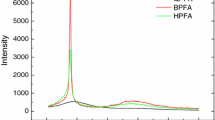Abstract
Novel N-halamine siloxane and epoxide coatings are described. The coatings can be rendered biocidal by exposure to dilute bleach. Once the bound chlorine is lost from the coatings, it can be regenerated by further exposure to dilute bleach. Synthetic schemes and biocidal efficacy data are presented. The stabilities of the bound chlorine on the surfaces are also addressed. Substrates employed include sand, textiles, and paint. Potential uses for the technology are discussed.

Similar content being viewed by others
References
Berger A (1983) Hydantoinylsilanes, US Patent 4,412,078
Chen Y, Worley SD, Kim J, Wei C-I, Chen TY, Santiago JI, Williams JF, Sun G (2003a) Biocidal poly(styrenehydantoin) beads for disinfection of water. Ind Eng Chem Res 42:280–284
Chen Y, Worley SD, Kim J, Wei C-I, Chen TY, Suess J, Kawai H, Williams JF (2003b) Biocidal polystyrene beads. II. Control of chlorine loading. Ind Eng Chem Res 42:5715–5720
Eknoian MW, Worley SD, Bickert J, Williams JF (1999) Novel antimicrobial N-halamine polymer coatings generated by emulsion polymerization. Polym 40:1367–1371
Elfersy JE, Berkner J, Moses TC (1999) Water-stabilized organosilane compounds and methods for using the same, US Patent 5,954,869
Elrod DB, Figlar JG, Worley SD, Broughton RM, Bickert JR, Santiago JI, Williams JF (2001) A novel biocidal elastomer. Rub Chem Tech 74:331–337
Emerson DW, Shea DT, Sorensen EM (1978) Functionally modified poly-styrene-divinylbenzene. Preparation, characterization, and biocidal action. Ind Eng Chem Prod Res Dev 17:269–274
Emerson DW (1990) Polymer-bound active chlorine: disinfection of water in a flow system. Polymer supported reagents 5. Ind Eng Chem Res 29:448–450
Hazziza-Laskar J, Nurdin N, Helary G, Sauvet G (1993) Biocidal polymers active by contact I Synthesis of polybutadiene with pendant quaternary ammonium groups. J Appl Polym Sci 50:651–662
Kanazawa A, Ikeda T, Endo T (1993) Polymeric phosphonium salts as a novel class of cationic biocides III Immobilization of phosphonium salts by surface photografting and antibacterial activity of the surface-treated polymer films. J Polym Sci A 31:1467–1472
Lambert JL, Fina GT, Fina LR (1980) Preparation and properties of triiodide-, pentaiodide-, and heptaiodide-quaternary ammonium strong base anion-exchange resin disinfectants. Ind Eng Chem Prod Res Dev 19:256–258
Lin J, Winkelmann C, Worley SD, Broughton RM, Williams JF (2001) Antimicrobial treatment of nylon. J Appl Polym Sci 81:943–947
Lin J, Winkelmann C, Worley SD, Kim J, Wei CI, Cho U, Broughton RM, Santiago JI, Williams JF (2002) Biocidal polyester. J Appl Polym Sci 85:177–182
Panangala VS, Liu L, Sun G, Worley SD, Mitra A (1997) Inactivation of rotavirus by new polymeric water disinfectants. J Virol Meth 66:263–268
Sun G, Allen LC, Luckie EP, Wheatley WB, Worley SD (1995a) Disinfection of water by N-halamine biocidal polymers. Ind Eng Chem Res 34:4106–4109
Sun G, Chen TY, Habercom MS, Wheatley WB, Worley SD (1996) Performance of a new polymeric water disinfectant. J Amer Wat Res Assoc 32:793–797
Sun G, Chen TY, Wheatley WB, Worley SD (1995b) Preparation of novel biocidal N-halamine polymers. J Bioact Compat Polym 10:135–144
Sun G, Wheatley WB, Worley SD (1994) A new cyclic N-halamine biocidal polymer. Ind Eng Chem Res 33:168–170
Sun G, Xu X (1999) Durable and regenerable antibacterial finishing of fabrics: Fabric properties. Tex Chem Col 31:21–24
Sun Y, Chen TY, Worley SD, Sun G (2001) Novel refreshable N-halamine polymeric biocides containing imidazolidin-4-one derivatives. J Polym Sci A 39:3073–3094
Worley SD, Chen Y, Wang J-W, Wu R, Cho U, Broughton RM, Kim J, Wei C-I, Williams J, Chen J, Li Y (2005) Novel N-halamine sioxane monomers and polymers. Surf Coat Intern Part B Coat Trans (in press)
Worley SD, Li Y, Wu R, Kim J, Wei C-I, Williams JF, Owens J, Wander J, Bargmeyer AM, Shirtliff ME (2003) A novel N-halamine monomer for preparing biocidal polyurethane coatings. Surf Coat Intern Part B Coat Trans 86(B4):273–277
Worley SD, Williams DE (1988) Halamine water disinfectants. Crit Rev Environ Contrl 18:133–175
Worley SD, Sun G (1996) Biocidal polymers. Trends Polym Sci 4:364–370
Acknowledgments
This work was supported by US Air Force Contract FO8637-02-C-7020 and by the Vanson-HaloSource Corporation.
Author information
Authors and Affiliations
Corresponding author
Rights and permissions
About this article
Cite this article
Liang, J., Wu, R., Wang, JW. et al. N-halamine biocidal coatings. J Ind Microbiol Biotechnol 34, 157–163 (2007). https://doi.org/10.1007/s10295-006-0181-5
Received:
Accepted:
Published:
Issue Date:
DOI: https://doi.org/10.1007/s10295-006-0181-5




